Katzhagen - Archive - October/November 2008
Engineering presents its latest developments
Due to a couple of unpredictable delays (just like in real life) and tasks engineering was forced to accomplish in addtion to the normal workload, the stuff which had been announced in May had to be put on hold for a while, but finally could be released now.
Two projects which had been scheduled since a long time were finished:
- A start delay for analogue locos
- An almost lossless stabilization for a LED taillight
Voltage stabilization for LEDs

Only minor space requirements due to just 11 parts
The simple circuits providing a
5V stabilization were a poor design in two aspects. The bridge rectifier
caused quite a lot of loss of voltage which resulted in useable illumination
only above 7V on the tracks and high power dissipation above 15V.
A completely different concept is shown in the circuit on the left. The bridge rectifier was replaced by Schottky-diodes featuring an extremely low voltage drop and voltage control was replaced by current control using a LM334 as a power source.
In result the LEDs light up constantly at already 4V and the circuit does not produce any waste heat. On top, short power outages of up to 0.8 seconds are ironed out by the capacitor.
A completely different concept is shown in the circuit on the left. The bridge rectifier was replaced by Schottky-diodes featuring an extremely low voltage drop and voltage control was replaced by current control using a LM334 as a power source.
In result the LEDs light up constantly at already 4V and the circuit does not produce any waste heat. On top, short power outages of up to 0.8 seconds are ironed out by the capacitor.
Inspired by an old picture showing a car transport along the Hindenburgdamm,
the LGB 4x59x flatcars were declared to be car transporters and one of these
was equipped with a tail light.

Car transport on the Hindenburgdamm
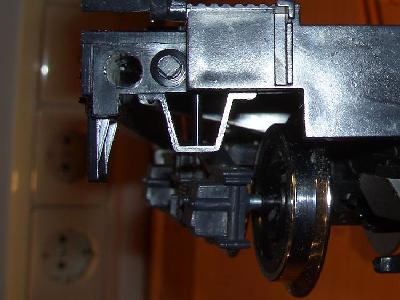
Bore in which a 5mm LED can be mounted
The heads of the LED lenses were cut off to imitate the original model.

Clamped LED and head nearly chopped off
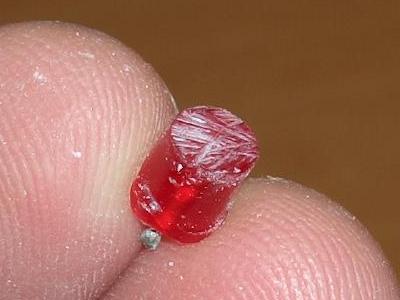
Headless 5mm LED
After cutting the heads the cut surfaces were sanded with grids of 240 and 600. The finishing was done with a grid of 8000 and a plastic polish.
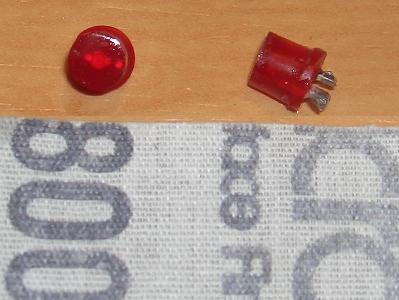
Cut surfaces after treatment
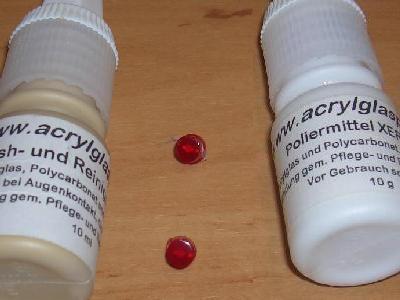
Polish for acrylic glass is suitable for many kinds of plastic...
Suitable mounting rings simplify mounting the LEDs. Applying a silvery paint to the visible part results in an impression of the original rings.
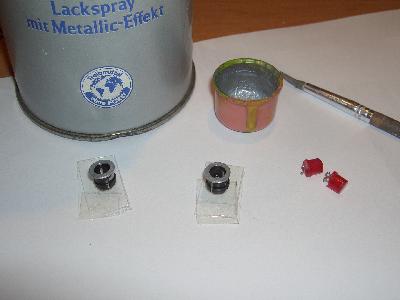
Faked light rings

Mounted LEDs
Stopp !! Hold it ! - LEDs out of the frame again!
The LEDs modified as shown above showed a quite nice result, but they were replaced by a type featuring a clear lense, lower power consumption and a better luminosity.
The following pictures show that the circuit's physical design does not need much space and therefor can be integrated into almost any car. Also you can see the clear LEDs mounted in the car transporter's frame.
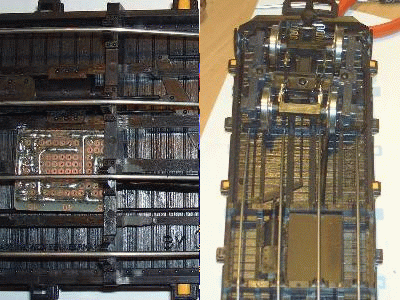
Circuit mounted underneath the chassis

Functional test passed !
A start delay
by simply decreasing the voltage supplied to the motor (f.i. by inserting diodes) results in the negative effect of a reduced maximum speed. This may be irrelevant with some models, but it definitely looks odd when the V200 crawls along the tracks with some Bm/Am cars at a model speed of almost 60km/h, while 24V are supplied to the track.A circuit had to be developed which would provide 0-24V to the motors and which would start to provide the motors with voltage only above 6V on the track. Below 6V on the track, the motors had to remain inactive and only the illumination and the sound module had to be supplied with power.
It was somewhat of a challenge to provide the motors with power in the way described above as the motors consume up to 4A. After a couple of experiments it turned out that it was feasable and that it was a better idea the circuit would adapt the voltage between 0 and 19V only. The following diagram shows a circuit which allows for this behaviour:

The motors remain inactive below 6V, above 19V an adaption is no longer necessary - track voltage is supplied directly to the motors then.
The picture on the right shows the board mounted inside the V200.
It's physical size allows for a mounting between both of the walls inside
the loco.
The circuit is connected between the DCC interface's pins providing the track voltage and the motors.
The pictures below show the different voltages on the track and at the motors. Two meters are used for a parallel measurement.
The yellow meter shows the motor voltage (1.14V on the left, 14.89V on the right), while the black one shows the track voltage (7V on the left, 15.9V on the right).
The circuit is connected between the DCC interface's pins providing the track voltage and the motors.
The pictures below show the different voltages on the track and at the motors. Two meters are used for a parallel measurement.
The yellow meter shows the motor voltage (1.14V on the left, 14.89V on the right), while the black one shows the track voltage (7V on the left, 15.9V on the right).

V200 start delay circuit

6V on the track but inactive... but in a moment...

above 19V the motors are supplied with the voltage supplied to the track
A pre-autumn inspection
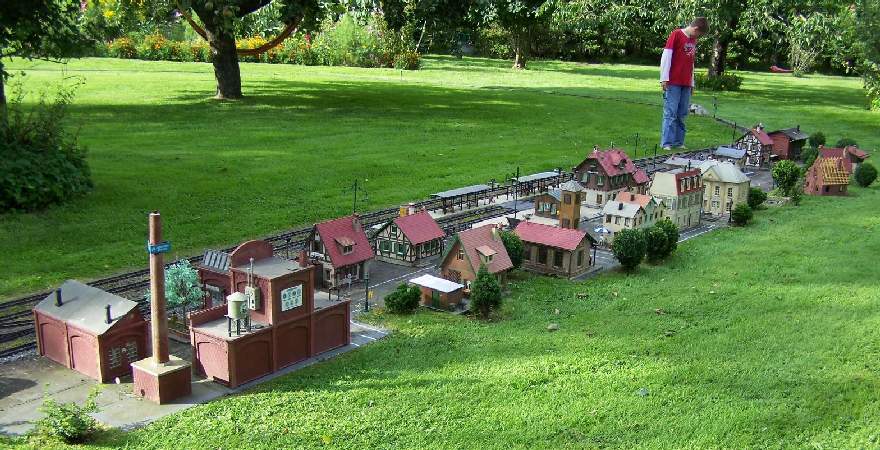
showed that one won't need to bother about a lack of work next spring.

